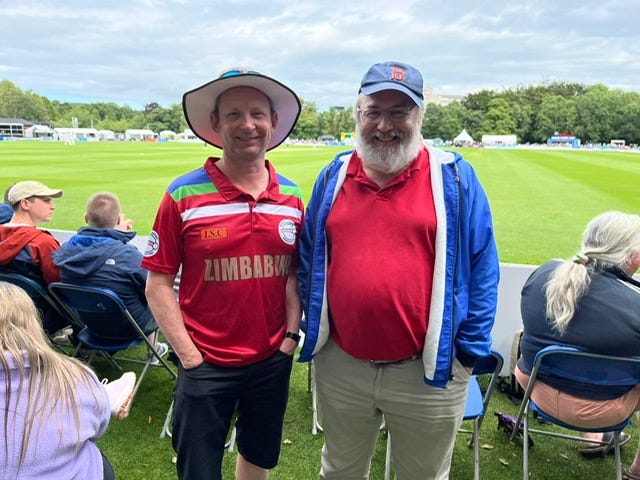There has been some concern in recent weeks that I may be viewed as an ‘anti-change’ regressive, a little too dedicated to the way things were and a little too reluctant to embrace change. But a love of Test cricket and support for the values it instils in the people who play it, and watch it, doesn’t mean a denial of progress.
Cricket South Africa should make full use of its right to schedule four-day Test matches, for instance. Plenty of fans have forgotten, if they knew in the first place, that home boards have this privilege. The last time a Proteas men’s Test was scheduled over four days was the one-off, day/night Boxing Day Test against Zimbabwe at St.George’s Park in 2017 but England, too, have played Ireland over four days.
Test matches rarely last five days in South Africa and the constant loss of the fifth day, and often much of the fourth, doesn’t make logistical or financial sense. Scheduling would benefit enormously, too, with Thursday to Sunday matches enabling three-match series to be concluded in three weeks. Add a few more overs each day and the difference between four and five days will hardly be noticed.
Since August 2016, the last drawn Test in SA (because a soggy, relaid outfield at Kingsmead precluded play on three days vs NZ), 25 out of 34 Tests have finished inside four days, including 10 out of the last 12.)
Names and numbers on players’ shirts was a long-overdue development and, frankly, who cares if a move to coloured clothing takes place. Advancements in ball technology should continue with the aim of developing a pink one which can be used successfully in day-night Tests and, indeed, in daytime Tests where the light is often poor and floodlights can be used – like Durban. Bad light stopping play is a scourge and a scandal.
And while we’re at it, the snobbery surrounding the sanctity of first-class status could also be revisited for the benefit of the game and its supporters. The solitary practise match before South Africa’s two Tests against the West Indies is being played over four days in Trinidad.
Jeremy Solozano (111) and Shamar Springer (131) made fine centuries for the West Indies Championship XI against not just a ‘full strength’ South African attack but, it could be reasonably be argued, an ‘above strength’ attack considering there were seven frontline bowlers rather than the usual four or five.
Why should their admirable efforts be discounted from their career records just because both teams wanted to give match practise to more than 11 players? Unlike some ‘warm-up’ games, which can lack intensity from the start and occasionally degenerate into inglorious throw-down net sessions (with fielders), this was a ‘contest’ between two teams desperate to either catch the eye of their national selectors or get ready for a Test match.
The best way to ensure total commitment from players in such a contest, over the full course of four days, and therefore to make it a watchable attraction, is to put their results on their CV. Professional cricketers know their stats, especially their first-class stats.
The international schedule ensures there are fewer tour games around the world than ever before with many Test series taking place with no more than a couple of days of nets. My suggestion is to make them relevant – if both teams agree.
It’s understandable that both teams would prefer to give meaningful match practise to more than XI players which, for the last 100 years or so, precludes the match from first-class status. But how about not bestowing the ‘match’ with first-class status (the result) but counting the players’ performances towards their first-class records? They’ll be no gratuitous slogging or bowling medium-paced long hops.
The best man to consult about the possibility was my long-time friend, commentary colleague and esteemed member of the Association of Cricket Statisticians and Historians, Andrew Samson: “I can’t see that ever happening, a match is either first-class or it isn’t,” he said before admitting that he could understand the argument. (Here he is at Stormont last week, ticking off Test venue number 59 in the company of long-time MoC subscriber, Jonathan Knowles, for the Ireland/Zimbabwe Test.)
“There would be more chance of winning an argument for granting first-class status to some matches in which more than eleven players are used, providing that no more than XI bat and field and nobody bats more than once in each innings. There would be merit in that in exceptional circumstances, such as in South Africa’s warm-up match, provided it suited both teams,” said ‘The Wizz.’
The host nation nominates the status of matches held within its jurisdiction and there are strict criteria which must be met, including no more than XI per team. Except, of course, that rule is regularly compromised these days with the use of concussion substitutes and, occasionally, the use of replacement players in the middle of matches when a player is called up for national duty. It wouldn’t be much of a stretch to include warm-up matches which are treated as ‘proper’ contests but make use of a squad rather than an XI.
“I can’t see that there would be more than ten such opportunities around the world every year, and probably less in which both teams want first-class status to apply. But it would undoubtedly make for a better contest and spectacle. The question might be, do the teams care about that – or is it just about ‘getting a few overs under the belt’ and ‘spending time in the middle’”, said The Wizz, failing to miss the head of the nail, as always.
But the concept must remain worth considering. The wickets and runs scored during the SA vs WI Championship XI were hard-earned. There was no coasting until, maybe, the last day. It was a flat pitch and, with no result likely, the game was ended early. That’s not unusual.
The game’s future may be complex but, one without a healthy component of Test and first-class fixtures will suit those currently benefitting financially, but it might not be healthy long-term. I suspect it won’t. (It won’t.)







I agree, 4-day tests are way overdue. I'm when old enough to remember the Currie Cup contests of 3 days & there were many exciting matches! Declarations were commonplace. A wasted 5th day costs many thousands of rands to spectators, vendors & host. Thursday to Sunday, or Friday to Monday (because they often end on 3rd). Cheers.